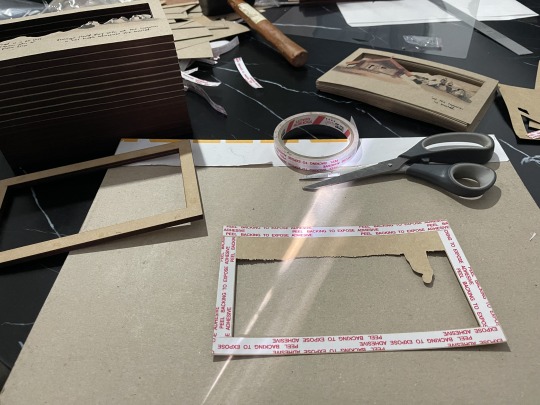Text
Reflection
When I contemplated whānau violence, I found it difficult to decide what approach to take. The reason for this is that there are many anti-violence campaigns over the years and yes, some of them are targeted at Maori but these have clearly not had a big enough impact as Maori still account for a lare percentage of the statistics for whānau violence.
I therefore decided that another awareness campaign would not have a big enough impact. It has taken generations for this learnt behaviour to entrench its way into our society so it only stands to reason to think that it will take a long time to 'unlearn' the behaviour.
This knowledge led me to explore how the whānau framework used to work and function before colonisation. Kaupapa Māori takepū (principles, values and beliefs) needed to be considered as it encompasses Māori wisdom and the culture processes, principles and the general way of life. It struck me at this point that what was needed was an approach by which whānau Māori could understand how whānau used to operate which was collaboratively. If Māori were to truly understand this and reconsider how they operate as a whānau, then only then can there be a change.
I realised that what i neded was an educational approach but the next obstacle for me was how to do this without becoming a book that no one will take the time to read. It had to be different, and it had to appeal to Māori and be relatable.
I discovered that by researching various anti-whānau violence campaigns, they were through a design lens which targeted either the abusers or the victims. I wanted to operate through a Māori lens which meant it needed to be targeted towards all Māori. I felt you just cannot focus on the abusers or victims as whānau violence effects everyone.
My initial thoughts initially was to have a narrative style education tool that would have sections for each member of the whānau and the effects that colonisation had on the whānau structure, but this seemed too formal as I was writing it and even with illustrations, it had no depth.
Stories of tūpuna and Māori mythology were passed down orally from generation to generation, which was why I was contemplating a story. Parents would read it to their tamariki and that way, they would also be learning how whānau used to function. The story therefore could not be too childlike as it needed to appeal to both adults and tamariki.
The story itself had to explain how whānau’s traditionally functioned. How they worked collaboratively together and that there was no head of the household. Furthermore and most importantly, it had to exhibit that there was rarely any violence within the whānau as there was no head of the household which was a learnt westernised value that was inflicted on Māori when the Europeans first settled in Aotearoa.
I wanted my outcome to be interactive and turned to the inspiration of whakairo here as you not only look at whakairo, you can also touch and smell it. If people interact with educational tools, they are more likely to remember them.
My colour palette was also based around whakairo as traditionally trees were used for whakairo. Red ochre was sometimes added to completed carvings if the whakairo were to do with high-born men or women. This story of Irirangi explains that she held and important role in the tribe as she was the first born child. This was the reason me including the ochre colouring on the outside of the panels.
I contemplated cards opposed to a bound book format and each card would be similar to a page of a book but this was not tactile enough which is when the concept of the panels emerged. By having each card on a panel, it was more interactive and by layering the cards on each panel, it became more tactile.
The next problem to arise was how would I ensure that the panels were kept in order as they could easily be mixed up. This is where the notion of magnets came from as if I built the magnets within the panel structure, they would stick together and would seem more cohesive as a story. The finished product appears to be a block of panels where you can pull each panel apart as the story is read.
The packaging for my outcome had to have significance to Māori as well. I contemplated some sort of stand that the panels could be placed on, but this notion felt too ‘museum-like’. I wanted it to relate to whānau which was why a harakeke kete was ideal as for Māori, harakeke symbolises whānau. A further significance of the harakeke kete was the fact that it can now be gifted to someone and passed down to the next generation. Whānau gifting the story of whānau in hope that it can eventually impact the social issue of whānau violence.
0 notes
Text
Mock ups






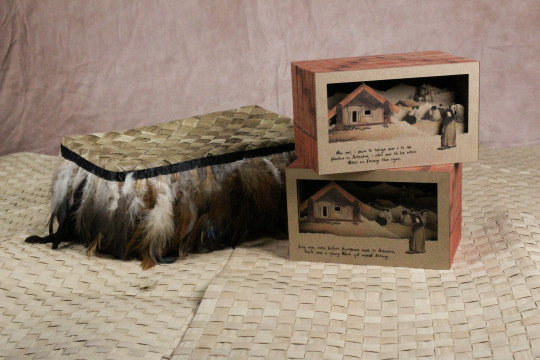



Photo's that I had taken of my final outcome. I have my own portable studio so was able to do this at home. I could not have been happier with my outcome.
It is so different than what I had first envisaged. I have made each little detail of this outcome kaupapa Māori. The story can be read (either in English or te Reo) to anyone and the exprience would be remembered as it is interactive in the way you need to take each panel in your hands when reading the story. The panels smell of smokey wood and you can feel the panels and the layers on the panels.
The kete can also be gifted to other whānau members and passed down to future generations so the story can be passed on and remembered.
1 note
·
View note
Text
Final Illustrations

My final story and illustrations. I wanted it to show traditional elements but in a contemporary way (without steering away to far from tradtiion). If you look for example at the final patterned image, this is my interpretation of whakairo.
i had to change the images many times over as the front image and back image of each panel had to be cohesive. Not only this however as when all the panels were together, it gave a different view so they all had to work cohesively.
My illustrations match th written text on the page and I tried to keep this as short and as simple as possible. The main thing was to get the message across about what whānau used to mean.
I kept to a colour palette of whakairo as it seemed more traditional than colourful illustrations and colour would just detract from the message.
I kept to a handwriting font as any other font did not look right. This was a story of a young girl in traditional pre-colonisation times and even though there was no writing then, it just did not see right to have a modern font.
0 notes
Text
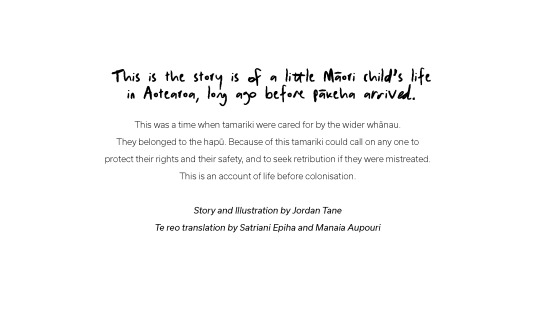
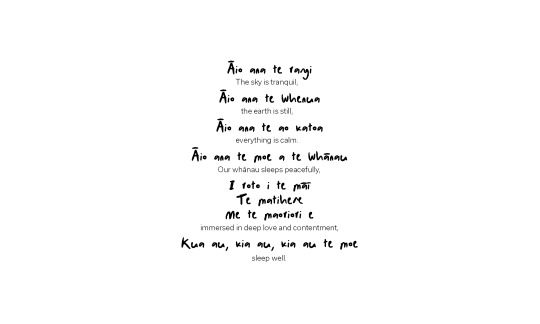
My whakatauki which is based on whānau. This is attached to the inside of the lid of my harakeke kete. I also thought it was necessary to include a panel that sits of the very top of the panel stack inside the box so the users know that it is.
0 notes
Text
Paneling


Poutama Pou= pillar, tama= a son Poutama is a well-recognised tukutuku pattern which takes the shape of stairs. This tukutuku pattern represents whakapapa (genealogy). The poutama steps symbolise the various levels of achievement in life.
By having this on the side panels, it adds more depth and ties in the concept of whānau even more.
1 note
·
View note
Text
Development
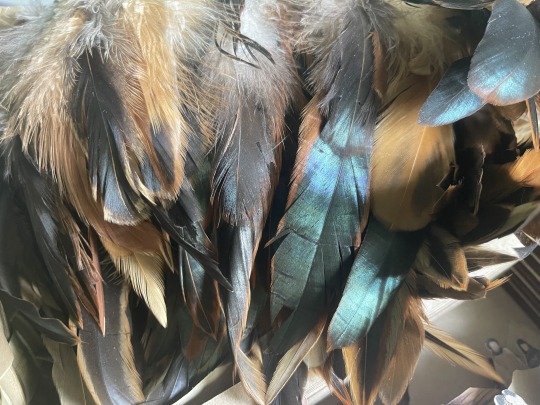




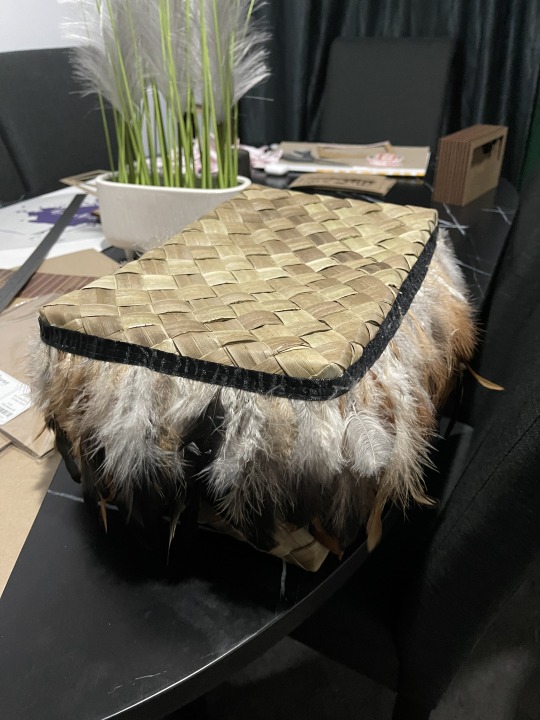
I had collected a number of things throughout this project that I thought I may be able to use in my final outcome. The feathers were perfect for the harakeke box I had made (with a bit of guidance from a friend who was an expert at weaving). I knew I wanted to attach the feathers to the kete and tried different methods but in the end was the trusty hot glue gun that worked the best and had the best and most professional finish.
When I had decided to do a Te Reo version as well, I needed then to make a bigger kete but needed a divider in the middle of the kete so they did not move around to much. Back to the weaving and then I tightly rolled it.
There was a roll of tukutuku styled band material that I had purchase but when I was putting everything together, it did not match the theme of what I ahd created.
0 notes
Text
Illustrations
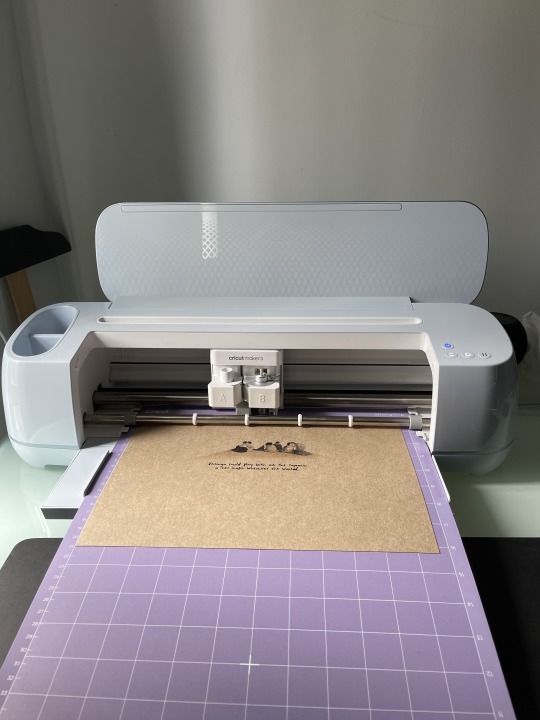





I brought a printer so I could do my own laser cutting. This was essential for this project as I neevr would have been able to cut them myself and to have them professionally done would have cost too much. I saw it as an investment as I now have this printer for other projects
There was a lot of trial and error involved in some of these as when you see it printed and laser cut, sometimes it did not look right so I needed to redo the illustration and print again. very time consuming but loved the finsihed products.
0 notes
Text
Te reo and English Story Translation
Mai anō, i mua te taenga mai o te iwi Pākeha ki Aotearoa, i noho mai rā he kōtiro Māori ko Irirangi tōna ingoa.
Long ago, even before Europeans came to Aotearoa, there was a young Māori girl named Irirangi.
I noho haumaru ia ki tōna pā harakeke o Ngāti Pāoa. Ki reira i arohaina, i takaro maha ki tana iwi, tana hapū.
She lived on a pā with her whānau, who were Ngāti Pāoa from Tāmaki. Irirangi had a great life. She could play with all the tamariki in her hapū whenever she wanted.
Piripiri ake nei a Irirangi ki tana māmā, tana pāpā otira tana teina a Nikau. He mea nui te whanaungatanga ki a rātou.
Irirangi was very close with her mama, papa, and Nikau her teina. Whānau life was a collective effort.
Ehara i te mea he kawenga mā tētahi ki te tiaki tamariki, tunu kai, whakatipu kai rānei.
Not one person was responsible for looking after the tamariki, or cooking, growing crops or making things that were needed.
He takohanga nā ia tangata. Mena kāore e taea tētahi te tutuki i tana mahi, he ringa hora nā te whānau ki te awhina.
Everyone was involved and had a part to play. If anyone was busy, then others were keen to help them out.
Mō tana hapū, he tokaanuku te māmā o Irirangi. Nā wai rā i ētahi wā ka tomo atu ia ki ngā wānanga huri noa te motu, ā, ka noho tahi ai a Irirangi me tana teina a Nikau ki te taha o tā rāua pāpā ki te kainga.
Her mama had a very important role in their hapū, and often she had to go to meetings. Whilst Irirangi’s mama was away, her papa would look after her and Nikau.
Hei te wā whakatipu kai he kawenga nui tō te māmā o Irirangi ki te whangai i te iwi, me te aha hoki he nui noa atu ōna pūkenga mo te whakatipu kai nō reira i waihō māna te katoa e whakahāere.
Irirangi’s mama also had an important role when it came to growing the crops that fed everyone. She seemed to have a gift with growing things, so was in charge of everyone who helped out.
He ngākau nui tō te pāpā a Irirangi ka mutu ngā pāpā katoa a tō rātou hapū.
Irirangi’s papa was very loving as were all papas in their hapū .
I karapotia a Irirangi e ngā tāngata ngākaunui ki a ia.
Irirangi was always surrounded by people who loved her and felt very loved and treasured.
He toki tōna pāpā i te ao whakairo, ā, nāna anō ngā whakairo i whakairo ki te pā.
Her papa was an excellent carver and was responsible for the whakairo for the pā.
Kua māmā ake taa Irirangi i te mea ko tōna koroua, ko ia tētahi o ngā kaumātua
Irirangi knew she was lucky as her koro was one of the kaumātua.
He pai noa ki a ia ki te noho ki te taha a ngā tamariki me te whakarongo hoki ki ngā kōrero tuku iho o ōna tūpuna. E ngākau nui ana ia ki ngā waiata tuku iho hoki o ōna tupuna hoki.
She loved to sit with all the tamariki and listen to the stories about their ancestors. Irirangi loved these stories. She also loved listening to the waiata as this too told the stories of their ancestors.
He hokinga mahara ēnei waiata oriori ki te wā I waiatahia ēnei waiata e tōna koro rāua ko tōna nani.
The waiata reminded Irirangi of the lullabies her koro and nani used to sing to her.
I kaha rangona a Irirangi I ēnei oriori I a ia e tipu ana me te aha hoki e kore rawa ia e hōhā I ēnei waiata inā hoki he oriori ēnei e kōrero mō ōna tīpuna ka mutu tōna whakapapa.
These oriori were sung to Irirangi over and over as she grew up. She was never tired of them. These were the stories of her ancestors and whakapapa.
Hei tā koro ki a Irirangi he tāonga ngā tamariki nō ngā atua ka mutu he wairua tā rātou. Nā koro te ingoa o Irirangi I tapa ki runga ki a ia. Ko te whakamāramatanga o tōna ingoa ko te reo wairua.
Her koro had always told Irirangi that tamariki were gifts from the atua, and they were spiritual. Koro had named Irirangi when she was born. Her name meant the spirit voice.
E ai ki a te koro o Irirangi, he hononga nui tō Irirangi ki tōna iwi. Koia te mātāmua kōtiro o tōna māmā otirā ko tōna māmā te mātāmua o tōna koro.
Irirangi’s koro told her she had a special place in their iwi. She was the first-born child of her mama, and her mama was the first born of her koro.
Tōna rite ki tōna māmā he haepapa nui tōna ki te whakatau he aha te aha mo te iwi. He āhuatanga pai tēnei ki a Irirangi.
Irirangi as well as her mama played a part in making all the decisions for the entire hapū. This made Irirangi feel very important.
He pai katoa te whakatipuranga a Irirangi me ngā tamaraki. I poipoi ka mutu he aroha nui ki ngā tamariki. Ka kaha mahi tahi ngā whānau me te hapū katoa.
Life was wonderful for Irirangi and all the tamariki. Tamariki were cherished and loved. All whanau and hapū worked together.
Mehemea he raruraru, he whawhai rānei he kaha te iwi ki te mahi tahi me te whakatau I taua raru.
If there was ever disagreements or fights, everyone worked together to resolve this.
0 notes
Text
Poutama

Poutama is one of the patterns of the tukutuku panels. It has a step-like pattern which traditionally symbolised genealogies as well as the levels of learning.
Of significance, it was said that the staircase was the one that the god Tane too to heaven in order to collect the three baskets of knowledge that he then brought back for the Māori people.
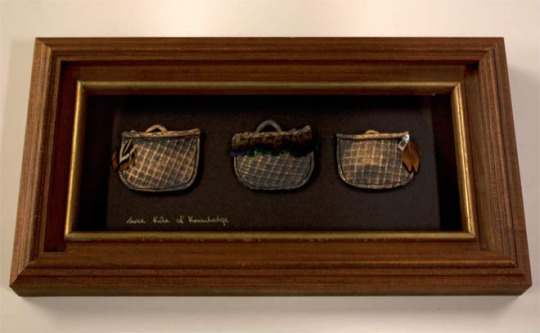
The 3 baskets of knowledge are as follows:
Te Kete Uruuru Tau Aronui - wisdom/ building/ arts/ agriculture
Te Kete Uruuru Matua Tuauri - ancient rites and ceremonies
Te Kete Uruuru Rangi Tuatea - The knowledge if incantations, war and magic. The tradition which includes the history of Māori
My Poutama | waipushrink | Blipfoto
Baskets of knowledge – ngā kete e toru – Māori education – mātauranga – Te Ara Encyclopedia of New Zealand
1 note
·
View note
Text
harakeke box development


My finished harakeke kete's. My first kete I made to fit the set of panels but then I had the idea to do a second set in Te Reo so needed a larger kete. Needed to ensure they were large enough to be able to put your hands in to place the panels or to retrieve them again.
0 notes
Text
Side Panels
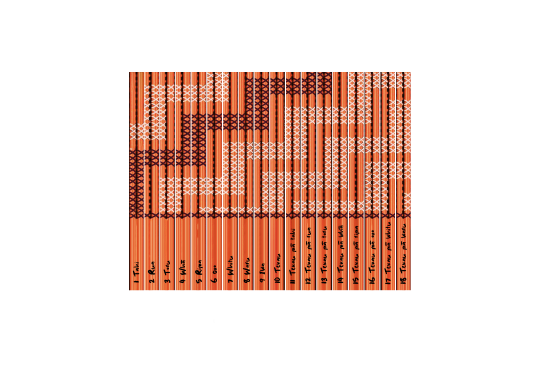

Poutama One of the better known tukutuku patterns where the stairs represent whakapapa (genealogy). They are also known to represent achievement in life and the levels you can go through.
My colour palette on the panels had been around the traditional wood that you would see in whakairo but have decided to add ochre red to these side panels as ochre red was traditionally added to the wood if the whakairo was to do with high-ranking mean or women.
In my story Irirangi did have a high ranking as she was the first born child of her mother who was also a first born child and was an important decision maker in the iwi.
1 note
·
View note
Text
illustration development Direction



My new laser printer gave me the opportunity to be able to illustrate very intricate drawings which mirror soem of the designs on whakairo. I would never have been able to got this effect simply through illustrations.
0 notes
Text
Harakeke




Harvesting of the harakeke. I ensured I got some help here so that I was doing it the correct way and following the protocols I had learnt. The day I was meant to harvest, it was raining so had to cancel that day.
The next fine day I tried again and was sure to cut the outer blades from the centre outwards on a diagonal from high to low.
I had done some weaving before so was just a refresher for me.
0 notes
Text
Print out draft final

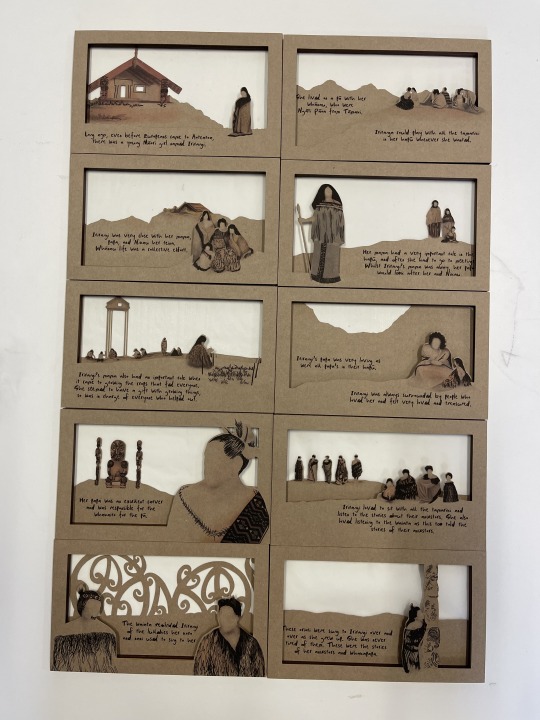
As mentioned previously, someone had given me the idea to put tissue paper between the layers of ach panel but when I saw it all together, it did not work. It obscured the effect of the layering and it did not look right so I removed them.
I am so happy with the design of the illustrations as they are cohesive and have the deired mix of traditional and contemporary that will appeal to anyone.
0 notes
Text
Final frame making
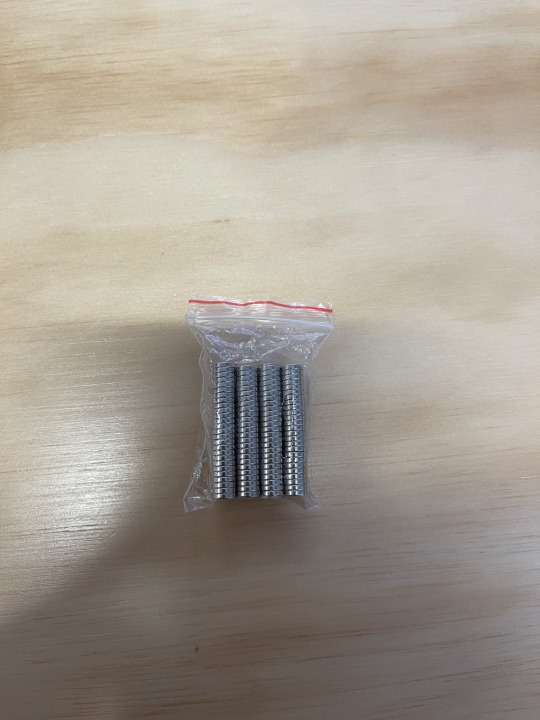

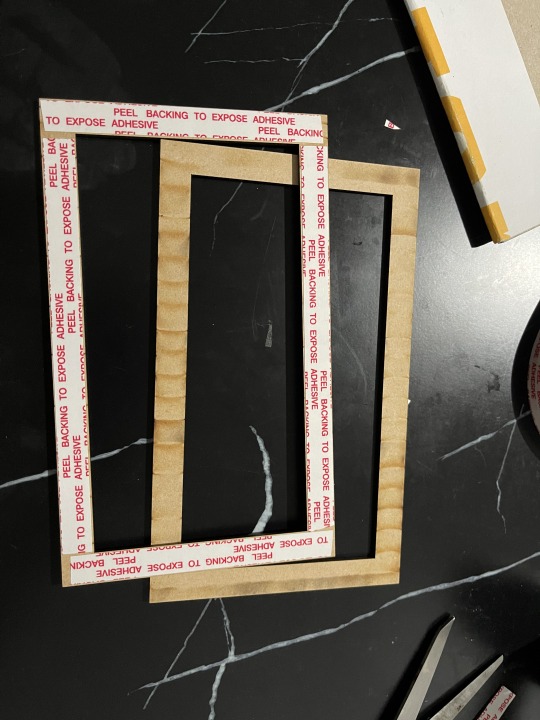
To make the panels, I had the wood laser cut and holes were drilled just large enough for the magnets I had ordered. From here I hammered in the magnets. I then used double sided tape to stick 2 boards together.
0 notes
Text
Pounamu workshop
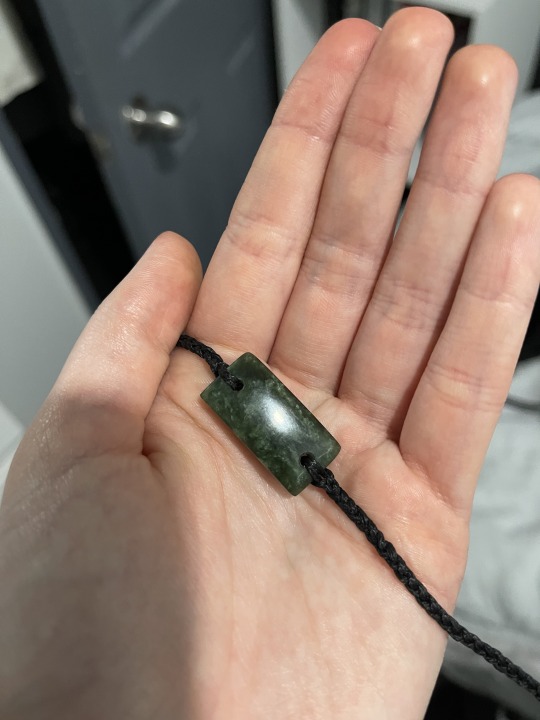

My mother has a friend who carves greenstone and on our last visit he showed me how to carve. This was what I made (with help from him of course). It didn't take long and was a lot easier than I thought.
This was the perfect opportunity to use it as Pounamu is meant to be gifted, so by placing it on my final outcome, the idea behind it is it should be gifted to someone.
1 note
·
View note

